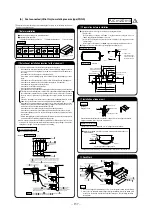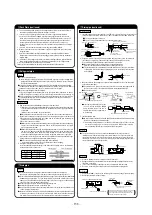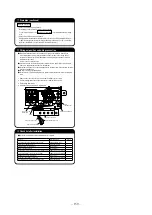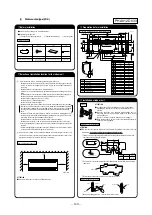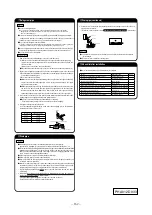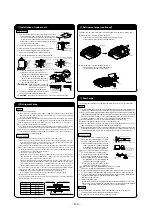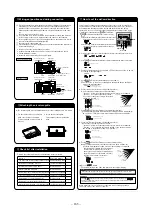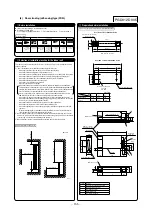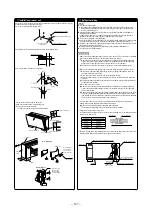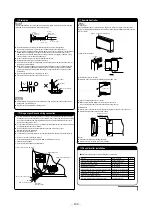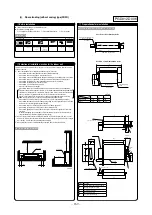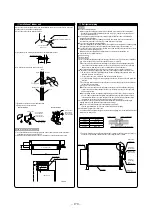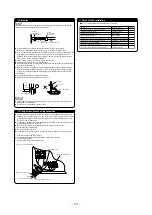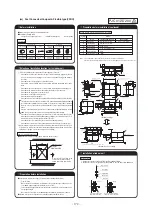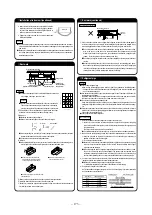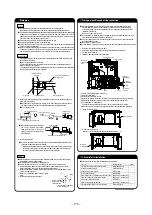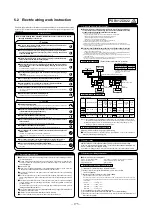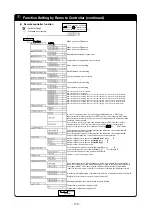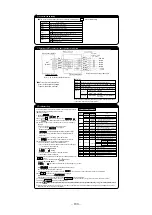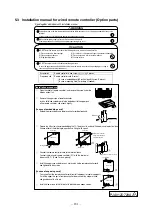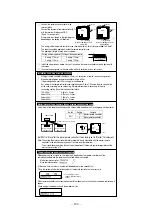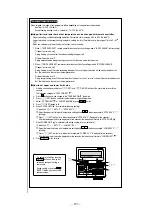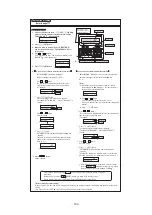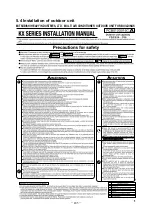
-
171
-
PGD012D006
8
Check list after installation
5
Refrigerant piping
Caution
l
Use the new refrigerant pipe.
When re-using the existing pipe system for R22 or R407C, pay attention to the following items.
・
Change the flare nuts with the attached ones (JIS category 2), and reprocess the flare parts.
・
Do not use thin-walled pipes.
l
Use phosphorus deoxidized copper alloy seamless pipe (C1220T specified in JIS H3300) for
refrigeration pipe installation.
In addition, make sure there is no damage both inside and outside of the pipe, and no harmful
substances such as sulfur, oxide, dust or a contaminant stuck on the pipes.
l
Do not use any refrigerant other than R410A.
Using other refrigerant except R410A (R22 etc.) may degrade inside refrigeration oil. And air getting
into refrigeration circuit may cause over-pressure and resultant it may result in bursting, etc.
l
Store the copper pipes indoors and seal the both end of them until they are brazed in order to avoid
any dust, dirt or water getting into pipe.
Otherwise it will cause degradation of refrigeration oil and compressor breakdown, etc.
l
Use special tools for R410 refrigerant.
Work procedure
1. Remove the flare nut and blind flanges on the pipe of the indoor unit. (The connection of Liquid/Gas
side of heat exchange, Inlet/outlet of the expansion valve box) (4 places)
Make sure to loosen the flare nut with holding the nut on pipe side with a spanner and giving
torque to the nut with another spanner in order to avoid unexpected stress to the copper pipe,
and then remove them. (Gas may come out at this time, but it is not abnormal.)
l
Pay attention whether the flare nut pops out (as the indoor unit is sometimes pressured.)
2. Make a flare on liquid pipe and gas pipe, and connect the refrigeration pipes on the indoor unit.
Make sure to connect the liquid pipe between the heat exchanger and expansion valuve box
(indicated in Section A of the figure).
Pipes can be take out in 2 directions, from the rear and from the floor.
Use the provided joint pipes to connect gas pipes. Connect in the direction that the pipe will be
removed.
Bend the pipe with as big radius as possible and do not bend the pipe repeatedly. In addition, do
not twist and crush the pipes.
Do a flare connection as follows:
l
Make sure to loosen the flare nut with holding the nut on pipe side with a spanner and giving
torque to the nut with another spanner in order to avoid unexpected stress to the copper pipe,
and then remove them.
l
When fastening the flare nut, align the refrigeration pipe with the center of flare nut, screw the
nut for 3-4 times by hand and then tighten it by spanner with the specified torque mentioned
in the table below. Make sure to hold the pipe on the indoor unit securely by a spanner when
tightening the nut in order to avoid unexpected stress on the copper pipe.
3. Cover the flare connection part of the indoor unit with attached insulation material after a gas
leakage inspection, and tighten both ends with attached straps.
l
Make sure to insulate both gas pipes and liquid pipes completely.
Incomplete insulation may cause dew condensation or water dropping.
4. Refrigerant is charged in the outdoor unit
As for the additional refrigerant charge for the indoor unit and piping, refer to the installation manual
attached to the outdoor unit.
Pipe diameter
Tightening torque N·m
F
6.35
14 to 18
F
9.52
34 to 42
F
12.7
49 to 61
F
15.88
68 to 82
F
19.05
100 to 120
There are "System name" and "Refrigerant amount" columns on the name plate of the outdoor
unit. Write the system name and the amount of the refrigerant in the columns.
Control box
Air filter
Expansion
valve box
Drain pipe
(Accessory)
Flexible tube
PT20A screw
Gas pipe
connecting
point
(Accessory)
Liquid pipe
connecting point
6
Drain pipe
Caution
Insert the attached drain hose to the indoor unit completely, tighten the drain hose with the attached
clamp and secure it well.(Disapprove of the adhesive joint)
Drain socket
Clamp
(Provided on
the drain hose)
Socket
(Provided on
the drain hose)
Drain hose
(Accessory)
VP-20
(Prepare on site)
l
Install the drain pipe according to the installation manual in order to drain properly.
Imperfection in draining may cause flood indoors and wetting the household goods etc.
l
Do not put the drain pipe directly into the ditch where toxic gas such as sulfur, the other harmful and
inflammable gas is generated. Toxic gas would flow into the room and it would cause serious
damage to user’s health and safety (some poisoning or deficiency of oxygen). In addition, it may
cause corrosion of heat exchanger and bad smell.
l
Connect the pipe securely to avoid water leakage from the joint.
l
Insulate the pipe properly to avoid condensation drop.
l
Check if the water can flow out properly from both the drain outlet on the indoor unit and the end of
the drain pipe after installation.
l
Make sure to make descending slope of greater than 1/100 and do not make up-down bend and/
or trap in the midway. In addition, do not put air vent on the drain pipe. Check if water is drained
out properly from the pipe during commissioning. Also, keep sufficient space for inspection and
maintenance.
l
Insert the attached drain hose completely to the base.
l
Tighten the drain hose with the strap and secure it well.
Indoor
unit
Descending angle
No bumps
No traps
Not to be in water
Drain test
l
After installation of drain pipe, make sure that drain system work in good condition and no water
leakage from joint and drain pan.
l
Do drain test even if installation of heating season.
Strap (Accessory)
Pipe cover (Accessory)
The thickness of insulation should be 20mm or more.
●
Check the following items after all installation work completed.
Check if;
Expected trouble
Check
The indoor and outdoor units are fixed securely?
Falling, vibration, noise
Inspection for leakage is done?
Insufficient capacity
Insulation work is properly done?
Water leakage
Water is drained properly?
Water leakage
Supply voltage is same as mentioned in the model name plate?
PCB burnt out, not working at all
There is mis-wiring or mis-connection of piping?
PCB burnt out, not working at all
Earth wiring is connected properly?
Electric shock
Cable size comply with specified size?
PCB burnt out, not working at all
Any obstacle blocks airflow on air inlet and outlet?
Insufficient capacity
7
Wiring-out position and wiring connection
l
Electrical installation work must be performed according to the installation manual by an electrical
installation service provider qualified by a power provider of the country, and be executed according
to the technical standards and other regulations applicable to electrical installation in the country.
Be sure to use an exclusive circuit.
l
Use specified cord, fasten the wiring to the terminal securely, and hold the cord securely in order not
to apply unexpected stress on the terminal.
l
Do not put both power source line and signal line on the same route. It may cause
miscommunication and malfunction.
l
Be sure to do D type earth work.
l
For the details of electrical wiring work, see attached instruction manual for electrical wiring work.
1. Remove a lid of the control box (2 screws).
2. Hold each wiring inside the unit and fasten them to terminal block securely.
3. Fix the wiring with clamps.
4. Install the removed parts back to original place.
CNW2
CNB
CNK1
CNK2
CND
CNA
Power source side terminal block
Indoor power source line
Earth
Remote controller line
Signal line (Shielded cord)
Signal side terminal block
Earth (Signal line)
L N
4
Installation of indoor unit
Choose the floor bracket bolt location or the wall installation bolt location, and the location of the pipe
hole. Open the holes for the bolts and the pipe.
Choose the positions by the measured values.
Floor installation 2 holes
Wall installation 4 holes
Wall penetration (Pipe hole)
Floor penetration
(Pipe hole)
Strictly adhere to the following measurements for the wall installation bolts.
Wall installation bolt
Wall
30
Here is the method to drill the holes on the wall.
Wall
Wall
Inside
Outside
Sleeve
Sleeve
Sealing plate
(1) Eliminate looseness with a level adjusting screw.
(2) Firmly secure as instructed below.
Floor bracket
(Accessory)
Floor installation
Wall installation
Frame side
Use a washer
and a double
nut to secure
to the floor bolt
Use a washer
and a double
nut to secure
to the wall bolt
Example of discharge duct installation
Heat insulation materials, a discharge grille and a peri-counter are not included in the items
supplied with a unit (to be prepared on site)
A duct must be installed securely so that cooled air may not leak inside the peri-counter.
Indoor unit
722
110
Duct 114
Discharge outlet
Peri-counter
UNIT:mm
Heat insulation material
20
Summary of Contents for 112KXE6
Page 105: ... 101 Model FDC335KXE6 A PCB003Z035 shows local wining ...
Page 134: ... 130 PJF012D003 ...
Page 135: ... 131 ...
Page 139: ... 135 PJA012D751 b ...
Page 140: ... 136 ...
Page 206: ... 202 2 model type DIS model type HEAD ...
Page 207: ... 203 2 2 ...
Page 208: ... 204 2 2 2 2 2 ...

